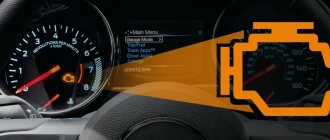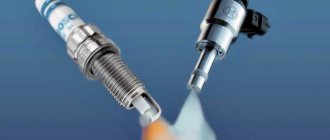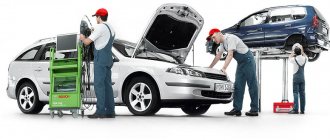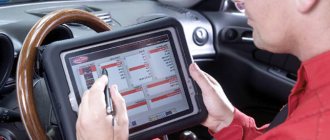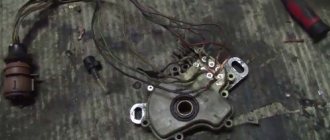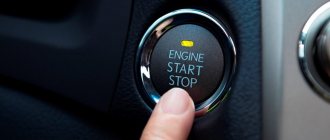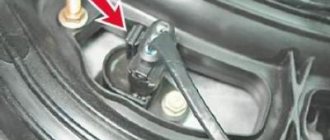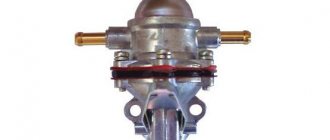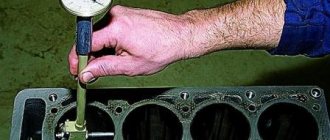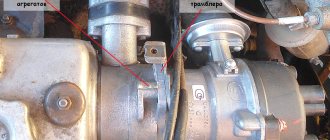What is computer car diagnostics?
The main condition for long-term and trouble-free operation of the car is diagnostics of the main systems and timely elimination of problems as they arise.
And if previously identifying a fault took a lot of time and had little accuracy, the use of new technologies has made it possible to quickly diagnose and repair breakdowns. What is computer car diagnostics? Car enthusiasts often do not understand the essence and features of such checks.
But here everything is simple. This is a test of electronic components and executive elements of the car that affect the functioning of the on-board system and the car as a whole. Using computer diagnostics, component faults are determined for further drawing up a special error map and correcting current faults.
When to get diagnosed?
Car enthusiasts avoid costs, so diagnosis often comes down to using “old-fashioned” methods or ignoring the problem. This approach leads to even more damage and costs in the future. To avoid problems, you should respond to the following symptoms of a malfunction:
- increased consumption of gasoline (diesel fuel) by car;
- malfunction of the accelerator pedal. When pressed, instead of accelerating, it slows down;
- the appearance of black and white exhaust;
- the occurrence of noises and knocks;
- increase in the warm-up time of the power unit (compared to previous indicators);
- reduction of power loss of the power unit.
The symptoms described above indicate obvious problems with the engine or other components of the car, which are determined by computer diagnostics. Checking will not be superfluous in the following cases:
- when buying a used car from a private owner;
- when independently preparing a car for sale. Carrying out diagnostics is a chance to accurately calculate the cost of the car;
- in a situation where the machine is used for a long time without repair;
- in cases where the car is used in extreme conditions (trips out of town, long journeys, difficult weather conditions, and so on).
How to choose a service station for comprehensive car diagnostics
In some areas there is only one garage service and all local car owners can only get service there. But for those who have the opportunity to choose a suitable salon, we advise you to treat this with full responsibility. How to choose a service station:
- contact an authorized dealer;
- get recommendations from your friends and acquaintances;
- read reviews from other car enthusiasts on the Internet.
The best place to start your search is on the Internet. Visit the websites of the relevant companies, analyze the ratings of car services, read reviews in aggregators. Perhaps this will help you decide.
Give preference to specialized services and technicians who deal with a specific brand of car. Then you will have a better chance of finding specialists who perfectly know the features of your car. Compare the cost of services in different salons, focusing on the average price tag. This will allow you to avoid overpaying for comprehensive car diagnostics.
Another good method for choosing a service station is to listen to the advice of acquaintances, friends or relatives. Surely one of them can share their positive or negative experiences and give you useful recommendations. Although, despite good advice, it is still worth looking for car dealerships on your own. Suddenly you will find better options.
If you belong to the category of wealthy and distrustful clients, we recommend that you contact a service station at official dealers. All work there is carried out strictly according to quality certificates, and the prices for services are inexpensive. In all major cities of Russia there are car dealerships of the most popular car brands, where you can order comprehensive diagnostics of a car before purchasing it from a dealer.
In any case, use the comprehensive verification service. Depending on the model and make of your car, it can cost you either one thousand or several thousand rubles.
A full comprehensive diagnostic includes:
- computer diagnostics;
- check on a lift;
- diagnostics of paintwork;
- engine check;
- steering condition assessment;
- suspension inspection.
Of course, this is an incomplete list of all the work that the master performs as part of the ordered service. However, it is these basic procedures that will allow you to find out if there are any internal technical problems that are not related to accidents. And also check whether the car has been in an accident.
Service station specialists have all the necessary equipment to carry out high-quality comprehensive diagnostics of the car and find out what condition its components are in, whether the mileage is displayed correctly, etc. Having completed the check, they draw up a list of work that needs to be carried out to restore the ideal technical condition of the car . This is especially important to know if you are just planning to purchase it. This way, you will understand how much more you will have to invest in your purchase in the future.
Diagnostic methods
Video: How to use computer diagnostics for cars
You will also be interested in:
Before starting repairs, the technician determines which mechanism is faulty. This requirement is relevant for all mechanisms under study, be it an engine or a suspension. Today, diagnosis is carried out in three ways:
- using human senses such as smell, hearing and vision;
- inspecting the vehicle, using instruments and measuring basic parameters;
- carrying out electronic (computer) diagnostics.
In practice, all of the above methods are used. The only difference is the duration and accuracy of the procedure. The first method is the simplest, but is not very accurate. The second is accurate, but involves a time investment. The ideal option is computer diagnostics of the car. Its essence is scanning nodes controlled by a microprocessor.
Check Features
New car models have an ECU (electronic control unit), which records current errors and notifies the driver of problems with a particular component. All faults are detected using special complexes. The service includes:
- car engine diagnostics, checking the operation of all sensors, controllers and systems;
- diagnostics of the correct operation of the crank group and ECU.
Car diagnostic program
Once all checks are completed, the current faults appear on the monitor screen. Next, the program reconfigures the ECU (if there are any violations). If the problem is a fuel system failure, the program determines a repair option. In addition to the engine, fuel system and cooling system, other systems are checked - the gearbox and chassis components of the car. With a comprehensive diagnosis, the likelihood of missing something is minimal. The specialist accurately determines the malfunction, which saves time searching for the problem and money on repairing serviceable parts.
General inspection
It is necessary to start carrying out this work only if you have a clean and washed motor, otherwise you will not be able to detect leaks.
Ideal option:
the engine runs smoothly, quietly and stably, the exhaust is colorless, fuel and oil consumption is within acceptable limits, there is no waste in the cylinder head. No traces of fuel or other fluid leaks were found on the engine.
The presence of one or more items may indicate a malfunction. Most often, the presence of a thin or loud knock means breakdowns associated with the crankshaft and valves.
Diagnostic nuances
Video: Computer diagnostics of the ELM327 car (Part 1)
A popular test is engine diagnostics, which is carried out using a scanner and a motor tester. First, the nodes are scanned - electronic diagnostics. The scanner is a personal computer (or laptop), which is connected via a diagnostic connector and reads error codes. A special feature of such a device is its assistance in controlling mechanisms and deciphering signals sent from microprocessor sensors. In practice, scanning is not enough to determine the fault. To obtain accurate results, a motor tester is used - a multichannel oscilloscope. The purpose of the device is to measure signals received from the on-board computer, display oscillograms and other data on the screen. Additional information allows you to draw accurate conclusions about the malfunction and decide what to do next. The equipment described above is available in two types:
- Stationary motor testers are devices designed for multifaceted vehicle diagnostics. In such systems, OBD-II is only a small part of the gas analyzer system, reading compression parameters, pressure in the fuel system, and so on;
- dealer scanners (specialized devices) are digital products that are multifunctional. It is essentially a combination of a small computer, an oscilloscope and a multimeter. The cost of a specialized device exceeds 2-3 thousand dollars, so you can only find it at a specialized service station.
Despite its accuracy and simplicity, computer diagnostics of a car takes some time. The problem cannot be identified instantly. The average duration of tests is 20-30 minutes, because specialists at the service station not only read error codes, but also decipher the ECU readings.
Stages of computer diagnostics of a car
Computer diagnostics of a car engine
Computer diagnostics includes testing of car electronics and units responsible for the operation of the main components of the vehicle - engine, suspension, cruise control, transmission, navigation, dashboard, and so on. The work takes place in several stages:
- Vehicle components are checked using available diagnostic tools, basic data is taken from vehicle components, and errors are read. At this stage, the service station worker must correctly decipher the scanner readings and draw preliminary conclusions about the malfunction;
- At the second stage, additional analog testing is done. The electrical part of the car is checked - wires, batteries, contact connections, generator. The master determines whether the system is working or not. Otherwise, the rest of the data will not matter;
- Vehicle parameters are checked online. The option name is “Data Strea”. Flow information is a chance to check signals from executive bodies and other elements. In this mode, the main parameters are visible on the screen of the testing device - fuel injection, sensors, idle mode, and so on;
- The data obtained during the verification process is analyzed. As already mentioned, the scanner produces basic oscillograms, which should be compared with typical ones for each car. Usually a qualified technician will have all this information at hand;
- Errors recorded in the controller memory are erased. After this, reinitialization is carried out. In some cases, it is necessary to repeat the initialization work (if the main parameters have been reset).
What do liquids say?
So, we look for the oil dipstick and pull it out into the light of day. Wipe with a clean cloth, lower it again and check the level. Above the middle, but below the max mark is ideal. The level between min and max is very good. Above max and below min is very bad, I would already give up the car at this stage.
Now let's assess the condition of the oil. No matter what the forum experts say, it is very difficult to do this without a chemical laboratory. Therefore, sniffing and licking the probe is practically useless; the information obtained from these actions is unlikely to give you anything.
It is much more interesting to look at the oil filler cap. It should be clean from the inside, deposits on it indicate the same deposits inside the valve cover, and this is a little more than just sadness. There cannot be any deposits on the lid. Plaque is a sign of overheating or the fact that antifreeze has gotten into the oil due to a broken cylinder head gasket or a cracked block (but this is less common). It is quite possible that the motor has experienced significant overheating, and this is a definite evil.
There cannot be any foam or signs of liquid heterogeneity in the oil. And the only thing you can see with your eyes is the color of the oil. Too dark is old, but don’t think that it should be exclusively transparent. Modern detergent additives are designed in such a way that they collect deposits, as a result of which the oil can darken. So here, too, everything is not so clear.
On some cars with automatic transmission, you can see the fluid dipstick in the automatic transmission. It is not found everywhere, and is now becoming less and less common. And if you see it, feel free to pull it out. But there is a peculiarity: on some cars there are marks that indicate the required level for the cold and hot box, on others you can only look at it at the hot box (in this case there may be a mark on the dipstick that says something about the temperature around 55 ° C ).
Now connect your developed sense of smell and sniff the probe with all the power of your lungs. The task is to catch the burning smell. If there is one, then most likely the solenoids do not provide enough pressure, the clutches do not close completely, slip and “burn”. As a rule, this is a prelude to a very expensive overhaul. You can assume that the car does not have an automatic transmission. It’s up to you to refuse or demand a discount for major repairs or a used unit for replacement.
If for some reason you doubt that you can correctly determine the oil level in the automatic transmission, look carefully at the dipstick: are there any bubbles in the oil? They can form from excess oil. And some especially gifted individuals overflow it to increase the pressure in the solenoids, lost due to contamination or deformation of the valve body channels. If the oil bubbles, it means that there is something wrong with the machine, and it is better not to buy this machine.
Now we look into the expansion tank. Antifreeze must be clean and free of sediment. A deposit usually forms if the technical genius of the owner decided to restore the tightness of the cooling system with some miracle liquid. Miracles don’t happen, and no one knows what’s going on in the system, but there’s definitely nothing good there.
I know that you are aware, but I repeat: the antifreeze level in the tank should be between the maximum and minimum marks, and you need to check it on a cold engine. And you definitely shouldn’t try to unscrew the expansion tank cap on a hot engine, it’s dangerous.
Now all that remains is to look at the level of fluids in the power steering reservoir, in the brake system and clutch reservoirs (if equipped). At the same time, check the tanks for leaks.
GENERAL INFORMATION
Modern cars, as a rule, are equipped with electronic systems that provide optimal control of the engine, transmission, brakes, etc. In most cases, each of them is “managed” by its own electronic control unit, operating according to a certain program in automatic mode. This eliminates the need for input and output devices for constant external intervention in the work process (monitor, keyboard, etc.). The need for communication with the electronic control unit and access to the readings of the self-diagnosis system arises only at the stage of vehicle maintenance or repair and is carried out using special methods. Troubleshooting
complex electronic devices is not an easy task, especially since their functioning in the vehicle’s electrical system is interconnected.
Objective diagnostics of electronic automation is possible only with the use of special tools, devices and equipment. It includes a set of actions, commonly called “computer diagnostics”. During its implementation, various operating parameters of the engine and vehicle are measured and compared with reference values. Diagnostic technology
involves mandatory verification of data received from the self-diagnosis system by measuring the relevant physical parameters.
For example, if an error code appears on the scanner display (see below), deciphered as “No signal from the coolant temperature sensor,” this does not mean that the sensor itself has failed. The fault may be in the wires connecting the sensor and the control unit, in the connectors, in the control unit itself, etc. To detect a fault, it is necessary to take a certain number of measurements of voltages, currents, resistances and determine the location of the damage. Based on the results obtained, malfunctions of individual systems, components, and assemblies are identified, then, taking into account indirect performance indicators, their technical condition is analyzed. Ultimately, it becomes possible to reliably assess the technical condition of the car, detect and eliminate the causes of deviations from the norm. Equipment necessary for diagnostics
can be divided into two groups: - instruments designed to measure physical quantities - ammeters, voltmeters, ohmmeters, pressure gauges, etc.; - devices that allow you to display in digital or graphic form the processes occurring during operation - scanners and motor testers. The main requirements for such devices are as follows: - completeness and accuracy of the information obtained, ease of operation, versatility; — availability of a reference data base for the largest number of brands and models of cars.
MEASUREMENT OF PHYSICAL QUANTITIES
Multimeters
are designed for measuring DC and AC voltage, AC and DC current, resistance, engine speed, temperature, contact angle, as well as testing diodes and transistors. Many of these devices allow you to record measured values, have an automatic shutdown function, as well as protection against incorrect connection and overload. Multimeters are necessary in any car service center and can be very useful for car enthusiasts. At the same time, they have a relatively low cost and high reliability.
Pressure gauges
of various types and purposes are used to measure the pressure of gases and liquids in vehicle systems and components.
An electronic pressure meter
is designed to determine the pressure of fuel, engine oil and control pressure in an automatic transmission, compression in gasoline engines, as well as vacuum in the intake manifold. The presence of a set of adapters allows you to service almost any imported and domestic vehicle.
Motor testers
They are quite complex devices that require certain knowledge and skills to use. Earlier models are devices for determining the operating parameters of ignition systems using an oscilloscope. Only when using them is it possible to measure high-frequency pulses created by ignition systems, since they have a duration of less than a millisecond with a voltage amplitude of up to 30 kV. Many modern motor testers are modular devices that do not have built-in devices that display results or measurements and must be connected to a computer. Using motor testers, they measure any voltages and currents, as well as pressures (discharges) of gases and liquids in various engine systems and components. Based on the data obtained, carburetor and injection engines with a classic, electronic or microprocessor ignition system are diagnosed. Motor testers allow you to quickly and objectively determine faults in the ignition, fuel supply, and gas distribution systems, as well as check the operation of the generator and battery charging. To do this, they include tools for statistical processing of the received data.
How to check a car engine before buying? (Photo and video instructions)
Good afternoon. In today's post, I will tell you how to check a car engine before buying. By carefully reading our instructions and watching the video, you will be able to diagnose the engine, even if you have never done this and have a very general understanding of the car’s structure.
How to check a car engine before buying without special tools?
Here's a video instruction for those who don't want to read:
Let's agree on the shore - such a check is very general, and when buying an expensive car, it is advisable to use diagnostic devices, since not all faults can be diagnosed without devices.
Attention. It is advisable if you inspect a “cold” car, this way you will learn much more about the condition of the engine.
Step-by-step instructions for checking an engine when purchasing without instruments.
We begin the inspection with the exhaust pipe. With a finger, or better yet, with a napkin, we wipe its inside and make sure that there is no soot (for gasoline engines, a diesel engine, especially an old one, will have soot). If there is soot, this indicates that the engine is either burning oil or has incorrectly configured fuel equipment. The reason will be determined by the color of the smoke, but that will come later.
The next step is to ask the seller to open the hood and visually inspect the engine. It’s great if the engine compartment is clean and a little dusty. In this case, all places of oil leaks are easily visible.
If the engine is washed, this indicates either the seller’s excessive love for cleanliness or a desire to hide small oil leaks .
If you observe oil leaks, you need to understand where the leak is coming from and how much it will cost to fix it. A leaking valve cover gasket is one thing - the cost of repair is 300-500 rubles. And another thing is the camshaft oil seal leaking, in this case the repair will cost 5-10-15 thousand rubles. Because You will also have to change the timing belt.
The next step is to look under the oil filler neck. If the season is cold, a light coating of emulsion is acceptable:
If you see a picture like this:
Probably, antifreeze gets into the oil, and this engine will not run for a long time. At best, it has a broken cylinder head gasket, and at worst, there are cracks in the cooling jacket. Those. There is a high probability of getting a contract engine replacement or major overhaul. At the same stage, take out the oil dipstick and check the condition of the oil. It should be something like this:
If there is an emulsion on the dipstick instead of oil, you can safely refuse the purchase or ask for a discount on the cost of the contract engine and the work to replace it.
The next step, if the seller allows it, is to unscrew the spark plugs and look at their condition. If you see a picture like this:
Everything is fine with the engine. If the spark plugs are covered in black soot, as is the exhaust pipe, this is a reason to refuse the purchase, since the engine is probably burning oil or has problems with the power system. In general, if you are allowed to remove the spark plugs, you can learn a lot about the condition of the engine from them, but we have a separate article about this, and there is no point in repeating ourselves.
The next step is if the pump is driven by an alternator belt, as on the classic VAZ A or ZMZ 402-406, we try to forcefully chat and feel the play. It is unlikely that with a tight belt you will succeed, but if you have enough health, this is a good reason for bargaining.
The next step is to start the engine and listen/watch. There should be no extraneous noise, much less knocking, in its operation, and the emergency oil pressure lamp should go out within 2-3 seconds. After that, go and look at the exhaust. If you observe bluish smoke, this indicates that the engine is suffering from oil leakage. Diagnosing the cause of this oil burn is very simple - if the engine smokes when re-gassing, after idling for 3-5 minutes, you can be sure that the problem is in the valve stem seals and repairs are not expensive. If the blue smoke comes out constantly, like in this video:
This indicates a faulty piston ring. And this is definitely a major overhaul or replacement of the engine with a contract one. It's expensive, maybe it's better not to buy it.
The next step is to open the oil filler neck with the engine running. The plug should be attracted, if the plug jumps, or even worse, tries to fly away, this indicates that the engine is faulty and the breakthrough of quarry gases is significantly increased. With a high degree of probability, the engine has reduced compression and, at a minimum, the engine will need to replace the piston rings, which means a complete disassembly and, in fact, a major overhaul. Remember - a working engine will suck the oil filler plug tightly.
The next step is after starting the engine and making sure there is no smoke or breakthrough of quarry gases. Warm up the engine to operating temperature (ideally before turning on the electric fan of the cooling system).
At the same time, we look into the expansion tank - no bubbles should appear in it, and there should be no oil stains on the surface of the antifreeze.
Turn off the warm engine and start it again. At the same time, look at the oil pressure lamps and check the engine. The check engine light should go off immediately after turning the key, and the oil pressure light should go off immediately after starting.
If after all these checks you do not see any faults, you can say that the engine is in good condition. But it is advisable to add several diagnostic devices.
Additional check of the engine condition using diagnostic tools.
When you go to view a car, it is advisable to have a few diagnostic instruments:
- Compressometer.
- Metal rod.
- ELM 327 or a specialized scanner for a specific vehicle.
- Endoscope.
How to check compression and what does it give?
The compression will show the approximate condition of the cylinder-piston group. Absolute values should be found in the operating manual for the specific vehicle. Scatter is important! The spread between cylinders should not exceed 10%. The verification procedure is as follows:
- warm up the engine
- turn out all the candles
- We measure the compression in the cylinders one by one, cranking the engine with the starter, with the gas pedal fully pressed.
Here's a short video measuring compression:
A metal rod is needed to listen to the engine and attachments.
— the rod rests against the running engine and is pressed against the ear (but not pushed inside). It's done something like this:
Using such a rod you can listen to the condition of the generator bearings, pumps, and even knocks in the crankshaft!
ELM 327.
Despite its availability (price about 200 rubles). This is a very useful diagnostic tool. With the help of the ego and the program in your smartphone, you can tell a lot about the condition of the car.
This scanner can read all engine errors, show the main parameters and can measure acceleration time. Actually, its capabilities are largely determined by the program used. It is important for you to look at the absence of permanent errors, the condition of the catalysts and the main parameters (temperature, idle speed, pressure in the intake manifold). We have a separate article on engine diagnostics using ELM 327 on our website, and there is no point in repeating it.
If you don’t yet have this wonderful scanner, you can order it without any extra charges on Aliexpress.
Endoscope.
If you plan to drive the car you are purchasing for a long time, it makes sense to take an endoscope with you for diagnostics. This pleasure costs from 4 to 30 dollars and, depending on the price, has different characteristics. To check for scoring in the cylinders, it is best to use more expensive devices connected via WIFI to a computer, since the image on the screen is larger. Here is a video with an example of engine diagnostics using a USB endoscope:
You can buy endoscopes here. Personally, I use this model for inspection.
Conclusion.
That's all for me today. I hope that in this article I was able to fully answer the question of how to independently check a car engine before purchasing. If you have objections, comments, suggestions, or just want to share your thoughts, write comments.
Best regards, administrator
Share
DEFINITION OF ERROR CODES
Error code scanners
are portable devices for reading fault codes. They are produced by various manufacturers under the names: Code-Reader, SmartTune, Creader, OBD II reader, etc. “Code readers” are mainly intended for small car services and car enthusiasts, as they are available and relatively inexpensive - for some models the minimum price is 1850 rubles per set. They can also be used for cars of the VAG group (Volkswagen Audi Group), which have their own connection system - four wires are connected in pairs. In many cases, scanners make it possible to quickly and easily determine faults, which is, in particular, necessary if the orange “Check engine” indicator lights up on the car’s dashboard. They are connected to the (OBD) connector, which is usually located inside the car. Then the ignition is turned on (the device can only be powered in this case) and four numbers appear on the liquid crystal display - an error code, which is deciphered from the attached book. During the process of determining the fault code, the scanner automatically tries to clear the error five times. If this fails, it can be assumed that there is serious damage and specialist intervention is required.
System scanner
is a small device with a color screen and a built-in miniature printer for printing reports. Modern versions of scanners have a minimum of buttons and information is entered using “touch screen” technology - by touching the screen. The device, according to a certain program, communicates with the electronic control unit, reads and displays information about operating parameters in an easy-to-read form. At the same time, it can perform the following functions: - reading and decoding error codes determined by the vehicle’s self-diagnosis system and stored in the memory of the control unit; erasing codes from memory, but the cause of the error is not eliminated; — display of vehicle operating parameters in real time; — impact on the control unit, sensors, actuators and their activation; — making changes to the operating program of the control unit within the competence of the service department and the technical capabilities of the scanner. The scanner communicates with the vehicle’s electronic systems in a “language” that is understandable to both parties, which is called a communication protocol and determines the set of “words” used and the order in which they are used. Since automakers often use their own original communication protocols, the scanner can only work with a certain list of car brands and models. Universal system scanners have advanced capabilities in this area.
In what areas are computer diagnostics used when it comes to a car?
The purpose of such a check is information about:
- the current state of the machine;
- ways to increase the functional efficiency of automotive systems;
- necessary troubleshooting measures.
Error codes are displayed on the display, which are deciphered using a special code reader, diagnostic stand and scanner. Based on this information, a decision is made on the necessary preventive or corrective work. In this way, not only the engine is checked, but also the gearbox, suspension, etc.
COMPLEX DIAGNOSTICS
Diagnostic complexes
are designed to carry out the most complete monitoring of the technical condition of a vehicle based on the analysis of measurement results of various physical parameters, the composition of exhaust gases and software scanning of electronic control units. A personal computer with a liquid crystal screen, mounted together with other devices on a mobile stand, is used as a base. At the same time, it is possible to further equip the complex with additional devices and equipment to expand its functionality. The most optimal composition of a modern complex includes: - a high-speed digital six-channel motor tester; — four-component gas analyzer; — universal system scanner; - Personal Computer; - lockable mobile stand. The main advantage of such complexes is their wide range of functionality and the fact that all elements are located in a single mobile lockable rack, and the wires are hidden and protected from damage.
What is included in a comprehensive vehicle diagnostic?
Obviously, it is simply necessary to carry out comprehensive vehicle diagnostics every year. It is also advisable to prepare for the changing seasons. We have compiled a list of the main components and parts that should be checked especially carefully:
- Heating (stove) and cooling (air conditioning) system. These important components ensure a comfortable ride at any time of the year. The reasons for checking them are already clear to everyone, so we will not analyze them in detail.
- The engine is the “heart” of the machine, ensuring the coordinated operation of all its components. The condition of the engine is analyzed using the latest computer technology, which allows us to detect any significant causes of possible breakdown.
- Electrical system. Comprehensive diagnostics allows you to detect and correct weak points in electrical wiring, timely repair generators and starters, as well as other important elements (including lighting devices: running lights, sidelights, headlights, etc.).
All wires must be protected with reliable winding. The risk of a short circuit should be eliminated as much as possible, because you will not be able to extinguish a burning car with a standard fire extinguisher. By the time you wait for the fire department to arrive, there will be nothing left to save.
- Clutch, brakes, chassis. Make sure that all components are working perfectly: “Airbag” and “ABS”, clutch discs and baskets, pads, steering rods, struts, springs, ball joints, silent blocks, etc.
Regardless of which salon you go to, comprehensive car diagnostics should be performed in several stages:
- general external examination;
- checking the engine part;
- full inspection of the chassis;
- comprehensive computer diagnostics.
A general external inspection is carried out visually and does not require the use of any electronic devices. At this stage the following is checked:
- performance of lighting equipment;
- condition of the body covering;
- condition of the interior.
If any problems are discovered during the inspection, the specialists will immediately eliminate them - remove heavy dirt in the interior and minor scratches, wash and polish the headlights or the car itself. If necessary, glass is replaced at this stage.
The most important stage of comprehensive car diagnostics is checking the engine. List of main works that the master must perform:
- Inspection of the injector is performed using an ohmmeter and a multimeter.
- Inspection of the engine as a whole. Does not require the use of any devices. The specialist checks the hood and engine compartment, assesses the presence and condition of all necessary accessories: clamps, sensors, wires.
- Comprehensive system diagnostics. To check the power supply and sensors, a special electronic scanner is used here.
- Diagnostics of the system responsible for filtering air in the cabin. This does not require any equipment; a specialist visually inspects the degree of contamination of the filter, checks the date of its installation and verifies the data. If the level of contamination increases, the filter must be replaced immediately.
- Checking the condition of the spark plugs. To do this, a car service employee needs to visually inspect the car, as well as find out its color and brand name.
- Connecting a scanner tester for complex computer diagnostics. It determines exactly when the electrical unit was installed and what version it is. It also allows you to make corrections to the computer systems and software of the car.
- Checking compression in cylinders. Filtered air is forced through the compressor, allowing the technician to learn about the contents of the engine.
The next stage of comprehensive vehicle diagnostics is an inspection of its chassis. It includes the following types of work:
- Full inspection of wheels and brake system. The salon employee assesses the condition of the wheel drums, hubs, tires, pads, and discs. He also inspects the brake lines and checks for leaks.
- Checking the support cups for any defects (at the same time as checking the elasticity of the spring).
- Inspection of the silencer.
- Checking shock absorbers. The specialist evaluates how stable they work and whether there are any leaks. If there is air suspension, inspects the cylinders.
- Diagnosis of traction. This is an inspection of backlashes.
- Checking CV joint boots. Allows you to identify abrasions or tears.
The above list identifies most of the work that is performed when carrying out a comprehensive diagnosis of a car. These procedures must be completed before purchasing a vehicle. This way you can detect hidden problems and make sure that the machine is working properly.
There are other types of vehicle inspections. However, their implementation is not directly related to the performance and safety of the machine. Therefore, they are classified as secondary (minor) activities and are carried out at the request of the customer. At the same time, some of these procedures are really important. For example: checking the body for the presence of putty dents, paintwork (the number of layers of paint on parts of a used car), etc.
RECOMMENDATIONS
If signs of malfunctions are detected, it is necessary to carry out appropriate diagnostics, since when carried out in a high-quality manner, the following are eliminated: - the need to perform unnecessary repair operations; — the risk associated with the possibility of replacing serviceable parts; — unreasonable financial, temporary and moral losses. An assessment of the technical condition of a modern car equipped with electronic control systems is objective and reliable only if the diagnosis is carried out by a specialist who has undergone special training and uses the appropriate equipment. Computer diagnostics involves repeated confirmation and comparison with reference values of fault data obtained by various methods using appropriate devices and tools.
What is engine diagnostics and what diagnostic methods are there?
There are many ways to diagnose an engine, but here are the main four:
- Visual diagnostics of engine components and assemblies
- Computer diagnostics of the engine, as well as other components and assemblies
- Instrumental engine diagnostics
- High-precision diagnostics with a motor tester
Let's look at each diagnostic method
To achieve the goal, it is necessary to understand when and how to use one or another type of diagnosis. In our experience of working with cars, often the absence of a “CheckEngine” light does not indicate the absence of a real problem in the engine .
The car's electronics cannot monitor the car's mechanical components. A modern car is very structurally complex and ambiguous, so it’s better to trust the professionals in their field.
So how to understand and make the right decision. Let's look at the types of diagnostics.
Visual diagnostics of components and assemblies.
A car service worker or someone who repairs your car must open the hood and visually inspect the engine compartment for visible defects. These include a torn wire, a torn hose, a lack of technical fluids, oxidation of wires, and so on.
This is often neglected not only in garage services, but also in large auto repair centers.
We always check the engine compartment and inform our customers about current faults. Very often we observe a lack of the required level of coolant, oil leaks, etc.
Computer diagnostics of the engine, as well as other components and assemblies
Many people think that computer diagnostics is a panacea for all problems . The car won't start, the tire has a flat, the gas has run out - no, computer diagnostics will not help with this.
Computer engine diagnostics are the eyes of the control unit, not the eyes of a mechanic or diagnostician. The computer does not give us complete information about a particular malfunction, but often confuses us and leads us down the wrong path.
Computer diagnostics only shows the further path for troubleshooting.
Each engine maintenance system has tolerances and there are parameters that the engine control unit cannot check or compare with the correct data. This suggests that the unit trusts the sensors, but the sensors can lie.
There is no error - is the machine working? Of course not. Indirectly, when diagnosing, you can understand where the trace of the problem leads, but do not hope for an easy solution to the problem.
Let's sum up the intermediate results.
Computer diagnostics are only a tool in troubleshooting . After all, the computer will not show physical quantities on the monitor display - fuel pressure, air leaks, engine compression, the performance of some sensors. Many people expect to undergo computer diagnostics and get all the information about the car - tire pressure, compression, temperature under the seat. Of course they won’t tell you this.
It is necessary to clearly understand that the car consists of 80% mechanical components and assemblies, and then electrical and electronics.
We are approaching the 3rd type of diagnosis.
Instrumental engine diagnostics
Example with fuel pressure.
Computer diagnostics let us know about the problem with the fuel. What's next? The computer won't help us anymore. We need a fuel pressure gauge. It is completely mechanical and the outputs are not transmitted by the engine control unit, but by We ourselves, based on the readings of the pressure gauge, whether there is a problem.
Let's take the example of compression.
Poor starting in cold weather. Different conclusions can be drawn - fuel pressure, bad spark plugs, clogged injectors. What if it's just bad compression? That's right, we need a compression gauge. I will not go into the description and principle of its operation, but I will say one thing - no computer diagnostics will show us compression. Only mechanical data collection from the compression meter.
There are many devices for instrumental diagnostics. I’ll just list the main ones - pressure gauge, compression gauge, smoke generator, pneumatic tester, pyrometer, stethoscope, video endoscope, vacuum gauge and electrical testers.
Bottom line
Computer diagnostics without visual and instrumental diagnostics is not a solution to the problem. You can visit many services and all to no avail, but by coming to Us and making a complete diagnosis, you will receive a 100% repair result .
We have come to the most complex and very effective diagnostic method
High-precision diagnostics with a motor tester
A motor tester is a device for connecting directly to the engine sensor and its mechanical part. We don’t need the scanner readings as such – it can only interfere with us.
How to perform computer engine diagnostics yourself?
Until the recent past, the ability to perform such computer diagnostics was available only to professional specialists who used appropriate equipment and specialized software for this. However, today on the Internet you can easily find appropriate diagnostic programs that are suitable for certain brands of cars. All you need is to buy the appropriate cable that allows you to connect a computer or tablet to the car control unit. The cost of such cables is not too high, so by paying a few hundred rubles you can purchase the connector you need, download the software and diagnose the car yourself.
Direct self-diagnosis does not present any difficulty. You need to connect your tablet or computer to such a control unit, run the program, then start the engine and let it run for a few minutes. During this time, the program will receive all the necessary information from the sensors and controllers built into the engine, and will provide the car owner with information in a readable form, which will allow us to determine the presence of certain problems and deviations in the operation of the power unit.
Conclusion
By performing high-quality engine diagnostics, you will be able to identify existing failures of the power unit, and based on the information received, you will subsequently be able to repair the engine, completely restoring its functionality. We can recommend that if you need to perform such diagnostics, you contact specialized specialists who are well acquainted with the features of the power units of your brand of cars, which will allow such specialists to identify existing breakdowns as accurately as possible and in the future you will be completely confident in the quality of the repairs performed.
01.03.2018
Computer diagnostics: goals and objectives
Computer diagnostics of the car helps to avoid software failures or malfunctions in the functioning of elements of complex mechanisms. As part of diagnostic activities, error codes detected during the analysis of the operation of the main components and assemblies are read and processed.
Diagnostic equipment includes specialized monitoring tools such as brand-specific diagnostic scanners, multi-function test benches, and hand-held readers known as “readers.” All these devices are connected to the car's diagnostic connector. Specialized computer equipment allows not only to record any changes in the operation of various systems, but also to erase detected error codes in order to correct them.
The driver can find out about possible defects and current errors in advance. The on-board systems of a modern car are equipped with an electronic control unit with a self-diagnosis function that analyzes the main systems of the car and notifies the driver of their malfunction.
Automakers recommend regularly conducting computer diagnostics of cars to ensure trouble-free operation of the most important vehicle systems. Only high-precision equipment, with the help of numerous electronic sensors and chips, is able to recognize a problem in the software of a particular node.
Stages of diagnostics
Computer diagnostics, regardless of the make and model of the car, includes several stages. Typically, it takes a specialist about 30 minutes to comprehensively diagnose all vehicle faults. The duration of analysis of one system, for example, ABS, takes about 10-15 minutes. To ensure that the service center employee has acted correctly, it is important for the car owner to know how the diagnostics are carried out.
- Typically, the first stage is general computer diagnostics, during which testing occurs without activating the main systems. Analog testing at this stage is carried out to check the electrical system, namely: connections, battery and generator.
- During dynamic testing, the machine is fixed on a stand equipped with special sensors, through which data on the operation of the systems is transmitted to a computer for further analysis.
- At this stage, the database collected by the on-board system is deleted (reset), and the control device is activated to collect information. Error codes recorded during the diagnostic process are deciphered using professional applications. As a result, the specialist receives accurate data about the problem of any electronic system of the car.
Where in St. Petersburg to get high-quality comprehensive car diagnostics
Our auto centers will perform comprehensive diagnostics of any vehicle with high quality. The company has been operating on the market for more than 20 years, providing high-quality services for servicing and repairing cars of all brands and any year of manufacture at affordable prices. Our Citroen service stations have the latest equipment and are equipped with special tools, and our employees are highly qualified.
You can get more detailed information on our website or find out directly from managers. We will be glad to see you at our service center!
Liked? Tell your friends:
When to get diagnosed
Car manufacturers recommend carrying out comprehensive computer diagnostics at least once a year, provided that the car is in good condition and there are no icons with errors visible on the on-board computer. If strange sounds or jerks or jolts that are uncharacteristic of the car appear while driving, you should contact a reliable service center as soon as possible for a thorough diagnosis of all systems. This is also worth doing in the case when the machine does not warn of a breakdown, but you feel that its behavior has changed.
Computer diagnostics of a car engine is carried out if you notice that the engine makes strange sounds, is unstable, loses power, and fuel consumption has increased. During diagnostics, specialists usually check the injection system, the correct functioning of the electrical system, and also measure compression.
Diagnostics of an automatic transmission is indicated when problems occur with shifting gears, jerks, jolts and slips that are unusual for the car, or when an oil leak is detected.
The suspension should be checked if the car's tires wear unevenly and a loud knock is heard when maneuvering while driving. In addition to computer diagnostics, a service station employee is required to conduct a visual inspection of the faulty system and give the necessary recommendations for repairing the car.
Highly qualified specialists from the official service centers of the FAVORIT MOTORS Group of Companies carry out high-quality computer diagnostics using certified equipment recommended by foreign automakers. The high level of service and favorable cost of work for car owners are the main reasons for the trust of numerous clients of FAVORIT MOTORS Group. Modern diagnostic systems used in our service centers allow us to detect faults in a timely manner, significantly reducing the cost of maintaining and further repairing the vehicle.
